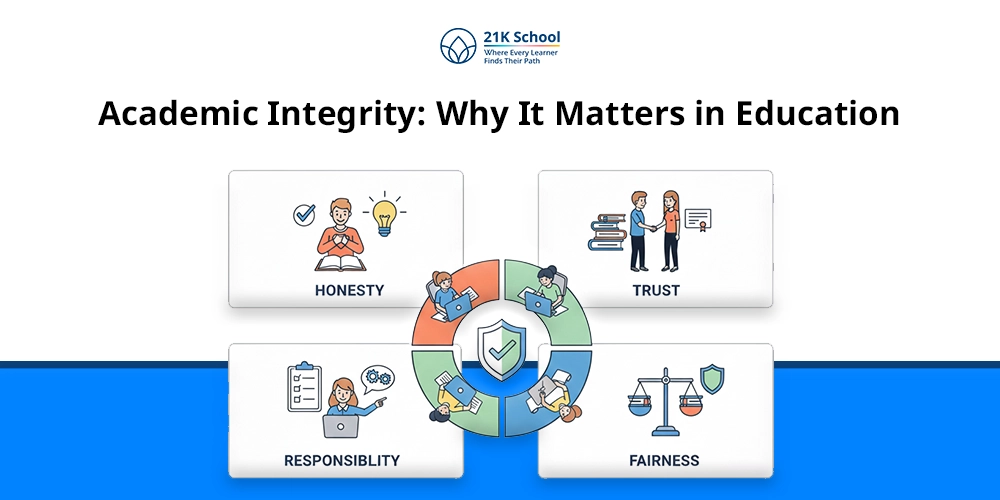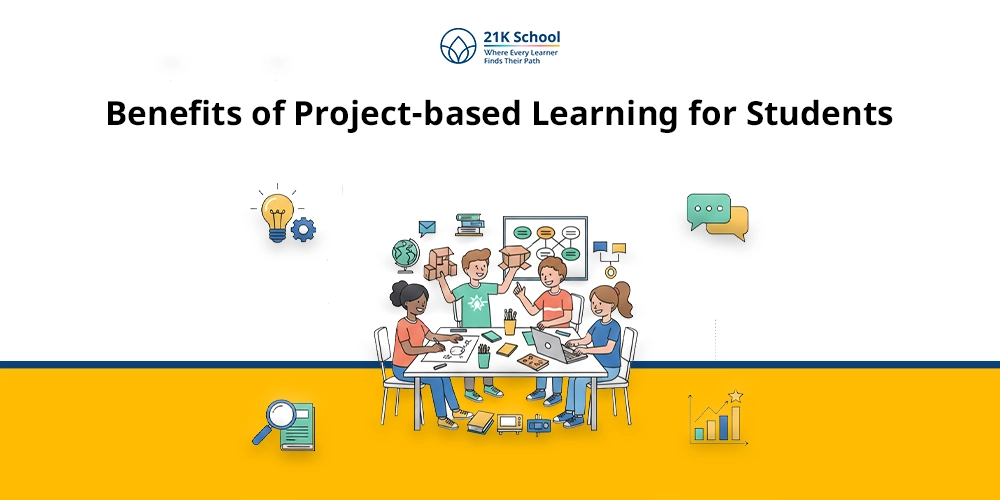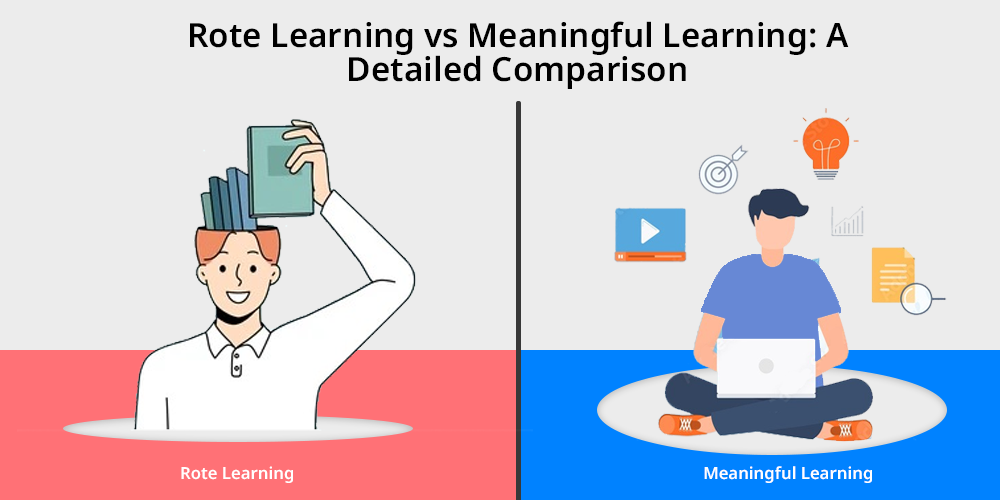
Education helps form students’ thoughts, gives them useful abilities, and encourages them to grow. During their studies, students meet various ways of learning, and every style has its own benefits and drawbacks.
A lot of attention is given to rote learning and meaningful learning. Many times, these two views are examined together, since they suggest completely different methods of learning.
Sometimes, we stick to memorizing something rather than trying to understand it. On the contrary, meaningful learning encourages students to better understand the material and use it in situations outside of school.
There are situations apt for each method, but knowing the details of each is important for assisting students.
This article discusses rote learning and meaningful learning in detail. It further highlights what each method offers, and looks into which is most suitable for students now.
Contents
What is Rote Learning?
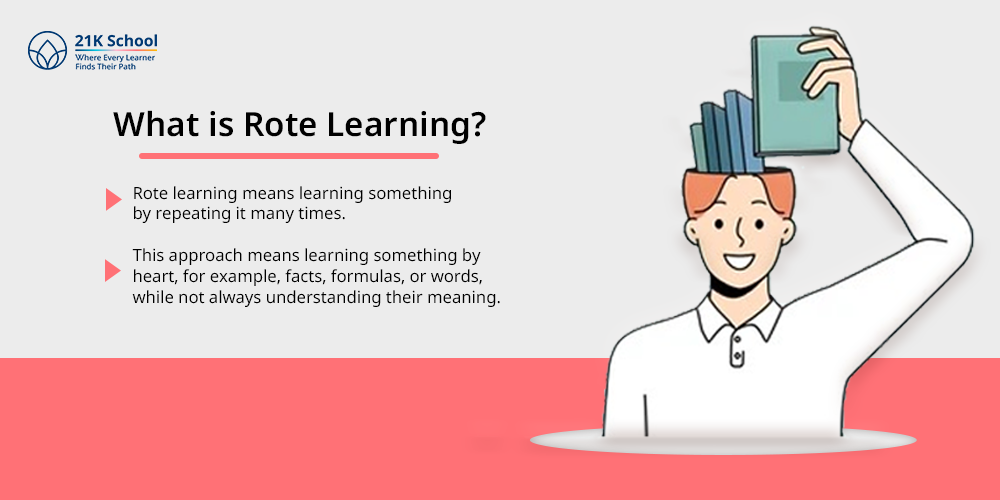
Rote learning means learning something by repeating it many times. This approach means learning something by heart, for example, facts, formulas, or words, while not always understanding their meaning.
Usually, students are asked to practice the same concepts many times to help them remember them. When using rote learning, students hardly apply what they learn.
Rote learning simply needs to recall the information, which commonly helps in math and language classes.
What is Meaningful Learning?

Meaningful learning requires learners to know the key concepts and see how they are related to what they currently understand. Through this method, students are able to grasp the ideas and link them with what they know in life.
As learners gather new information and link it with their existing thoughts, they learn better and become more useful.
When learning is significant, it benefits problem-solving knowledge application, and skill in reasoning. Instead of just learning facts, students analyze the content and try to see how it can be useful in more situations.
Difference Between Rote Learning and Meaningful Learning
Rote learning and meaningful teaching, both seem to be two faces of the same coin. However, it is crucial to understand their differences and find what suits who among the two.
| Features | Rote Learning | Meaningful Learning |
| Approach of Learning | Stuffing information with memorization | Learning through context and connections |
| Aim or Focus | Memorizing Facts | Learning through comprehension and deep-understanding |
| Retention Type | Short-term Retention | Long-term Retention |
| Critical Thinking Skills | Doesn’t include analyzation of facts | Includes analyzation and critical thinking |
| Involvement of Learners | Not really involved | Highly involved |
| Application in Real-world | No real applications | Real transfer of knowledge to different aspects of life |
| Assessment and Evaluation | Can be done easily by traditional tests | Requires structured projects to evaluate. Time-taking |
1. Approach
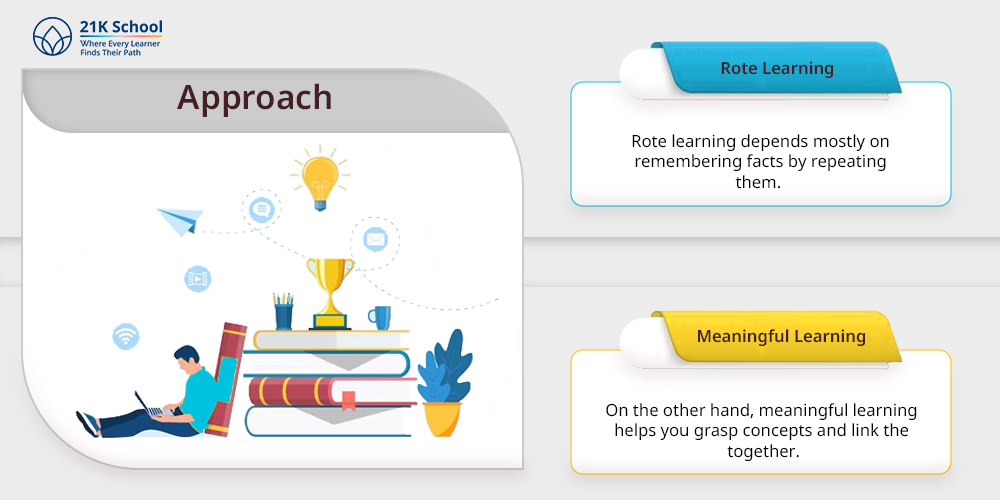
- Rote Learning:
Rote learning depends mostly on remembering facts by repeating them. It makes learners go over a subject again and again until it becomes part of their memory.
While the learner may not understand the information in detail, they just manage to remember it. As an example, students could recall multiplication tables or historical periods without being able to explain their importance.
- Meaningful Learning:
On the other hand, meaningful learning helps you grasp concepts and link them together. Learning happens best when you link the new experiences with what you already understand.
The learner tries to make sense of the information and its role in the subject instead of just remembering them. This would mean studying the reasons behind historical events, instead of just noting down the times they occurred.
2. Focus
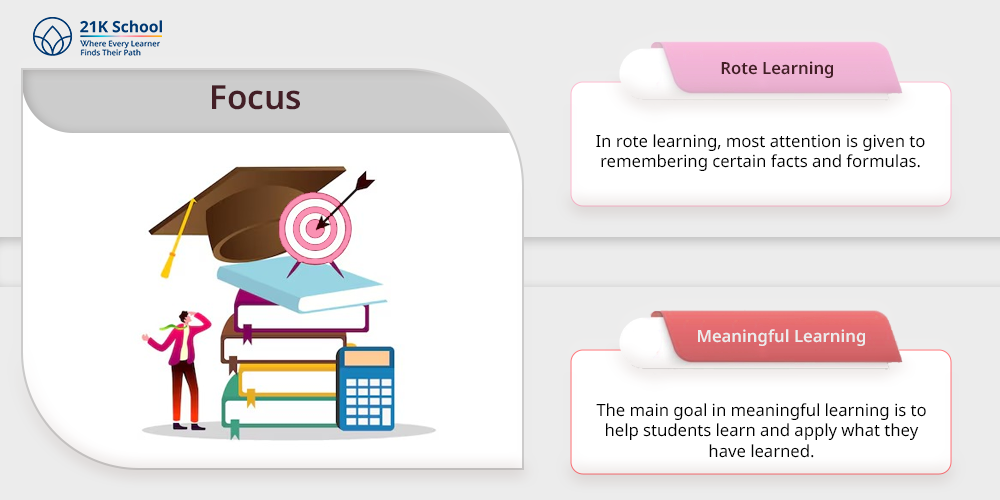
- Rote Learning:
In rote learning, most attention is given to remembering certain facts and formulas. Students are told to keep repeating the material, mainly focusing on understanding facts rather than their significance.
- Meaningful Learning:
The main goal in meaningful learning is to help students learn and apply what they have learned. Its aim is to guarantee that the learner grasps the concept fully and can use it in different areas.
The main point is to learn important concepts, enhance critical thinking skills and use the knowledge in different situations.
3. Retention
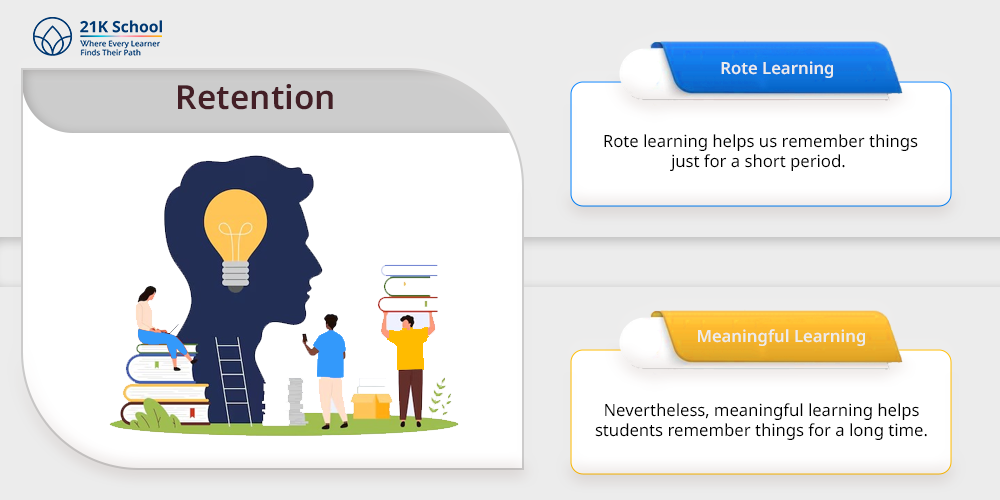
- Rote Learning:
Rote learning helps us remember things just for a short period. People may easily forget what they have learned since the material is not well-understood yet.
It is possible that someone learns a phone number and then quickly forgets it.
- Meaningful Learning:
Nevertheless, meaningful learning helps students remember things for a long time. Remembering information long after the lesson is possible because it is connected to what the learner already understands.
Being involved with the material helps students keep information longer.
4. Critical Thinking
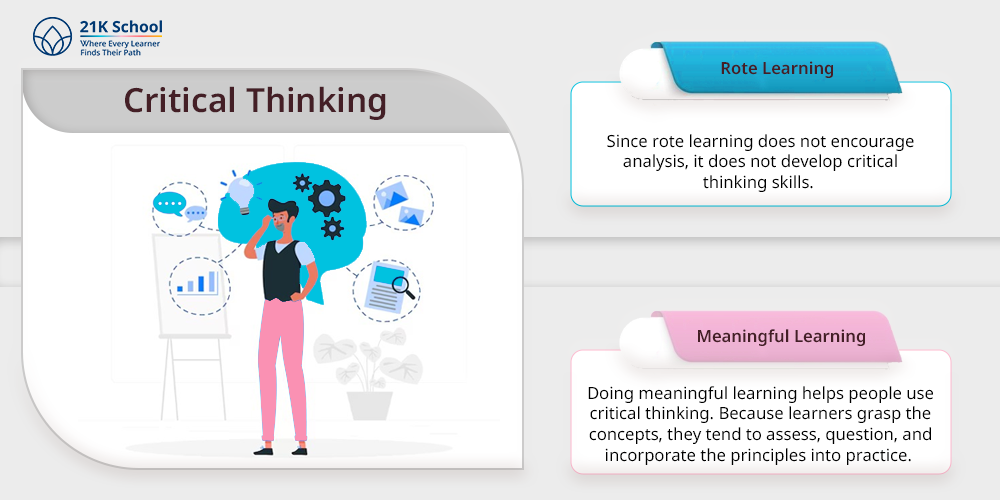
- Rote Learning:
Since rote learning does not encourage analysis, it does not develop critical thinking skills. In rote learning, students only have to remember information and never use critical thinking.
In this type of learning, thinking deeply about the subject is not encouraged for the learner.
- Meaningful Learning:
Doing meaningful learning helps people use critical thinking. Because learners grasp the concepts, they tend to assess, question, and incorporate the principles into practice.
Their thoughts turn to how various theories link, contest common beliefs, and help solve difficult problems. Such learning encourages people to be curious and come up with new ideas.
5. Engagement
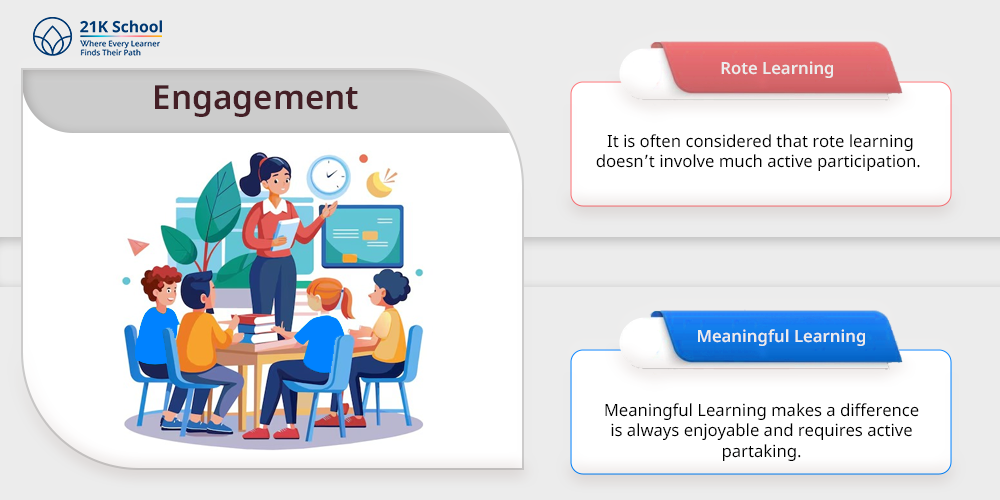
- Rote Learning:
It is often considered that rote learning doesn’t involve much active participation. Because the learner repeats the same thing in rote learning, it may be boring for them.
If learning doesn’t have any purpose, it may simply feel like repeating exercises instead of using your mind.
- Meaningful Learning:
Meaningful Learning makes a difference is always enjoyable and requires active partaking. Students relate the subject to the world around them and actively solve stimulating issues.
Taking part in fun-learning activities makes the process more engaging and makes learners more interested.
6. Practical Application

- Rote Learning:
The use of the knowledge learned is usually quite limited in rote learning. Students might find it hard to apply the knowledge they have acquired in real-life situations after they leave school.
Having a formula memorized is not always enough to do difficult problems, as understanding the underlying ideas is also necessary.
- Meaningful Learning:
Having meaningful learning, a person can bring their knowledge into different parts of life. By having learned the basics, people can apply the information in several ways.
For example: Knowledge of chemistry gives a student the ability to experiment and solve chemical-related problems.
7. Motivation and Interest
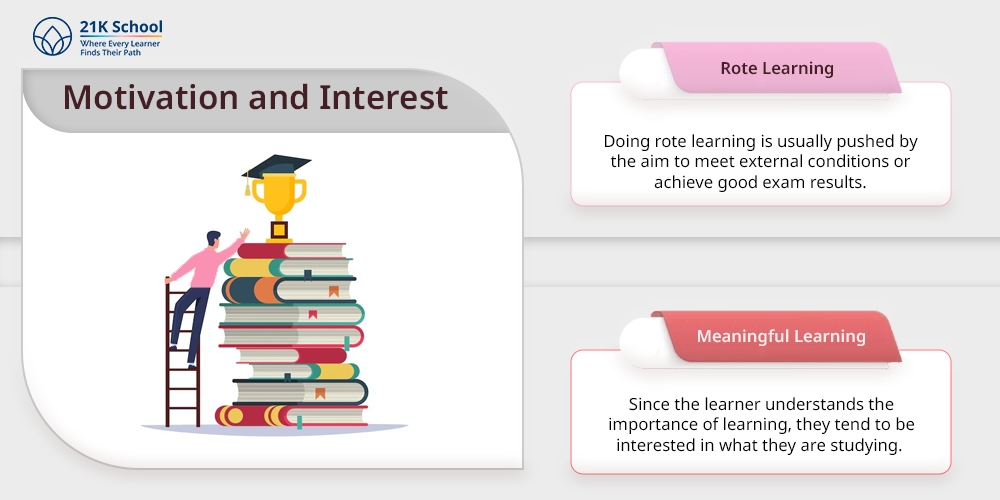
- Rote Learning:
Doing rote learning is usually pushed by the aim to meet external conditions or achieve good exam results. Some learners just memorize facts, just to get good results in their exams, rather than caring about the subject.
This often ends up with the student not being interested in learning just for its own sake.
- Meaningful Learning:
Usually, the motivation in meaningful learning is something people feel inside. Since the learner understands the importance of learning, they tend to be interested in what they are studying.
A strong interest can encourage someone to learn more and enjoy more success in the future.
8. Assessment
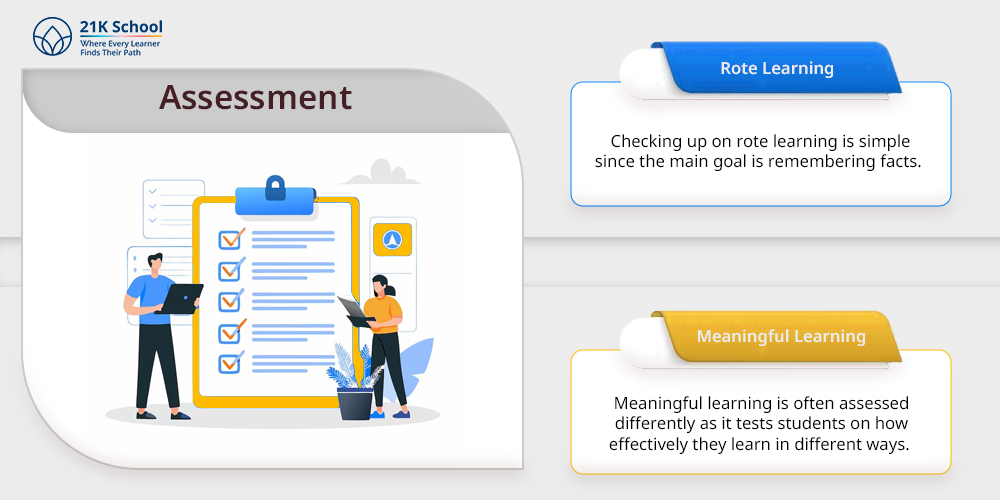
- Rote Learning:
Checking up on rote learning is simple since the main goal is remembering facts. Exams and tests in schools often make students recall and explain particular facts or a specific sequence of actions.
It is simple to set up and assess these types of tests.
- Meaningful Learning:
Meaningful learning is often assessed differently as it tests students on how effectively they learn in different ways. For this type of learning, students may be assessed through projects, essays, or performances, which take time to score.
Also, conventional tests may not measure as well the important aspects of meaningful learning.
Read on to learn more about difference between assessment and evaluation.
9. Teacher’s Role
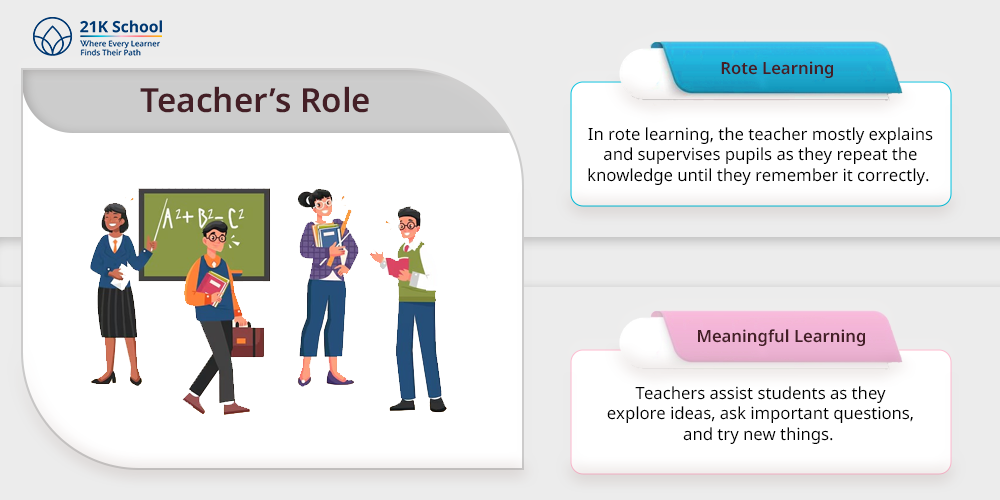
- Rote Learning:
In rote learning, the teacher mostly explains and supervises pupils as they repeat the knowledge until they remember it correctly. The role of teachers in lectures is often to deliver the main knowledge to students.
- Meaningful Learning:
In this kind of learning, the teacher helps learners learn on their own. Teachers assist students as they explore ideas, ask important questions, and try new things.
Teachers give students chances to link what they know to their past knowledge and use it in new circumstances.
10. Cognitive Load
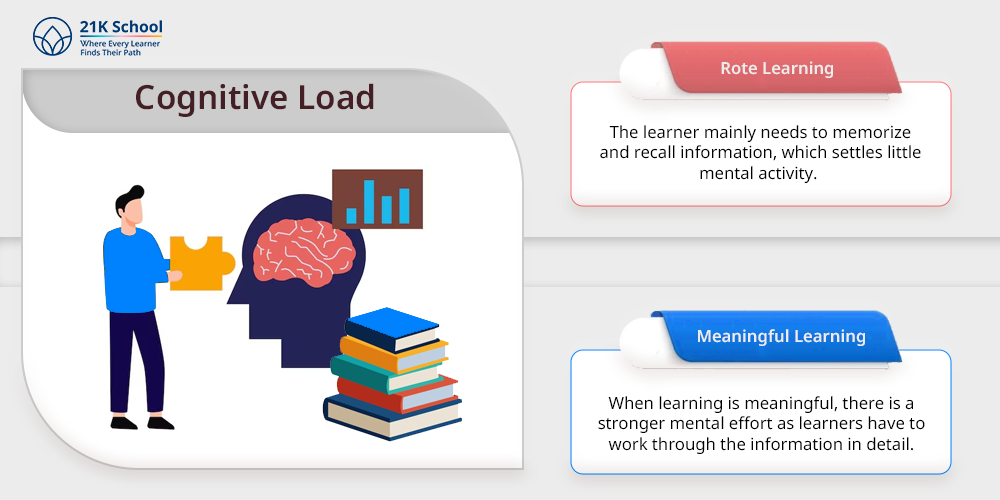
- Rote Learning:
With rote learning, the learner mainly needs to memorize and recall information, which settles little mental activity. While the learning process is repeated, it becomes more tiring.
As a lot of information is crammed in a short amount of time, the mental pressure or load increases.
- Meaningful Learning:
When learning is meaningful, there is a stronger mental effort as learners have to work through the information in detail. It usually requires collecting data, merging it with previously learned facts, and finding solutions to challenging questions.
Even so, carrying out such deep learning helps people remember things for a longer period.
11. Long-Term Impact
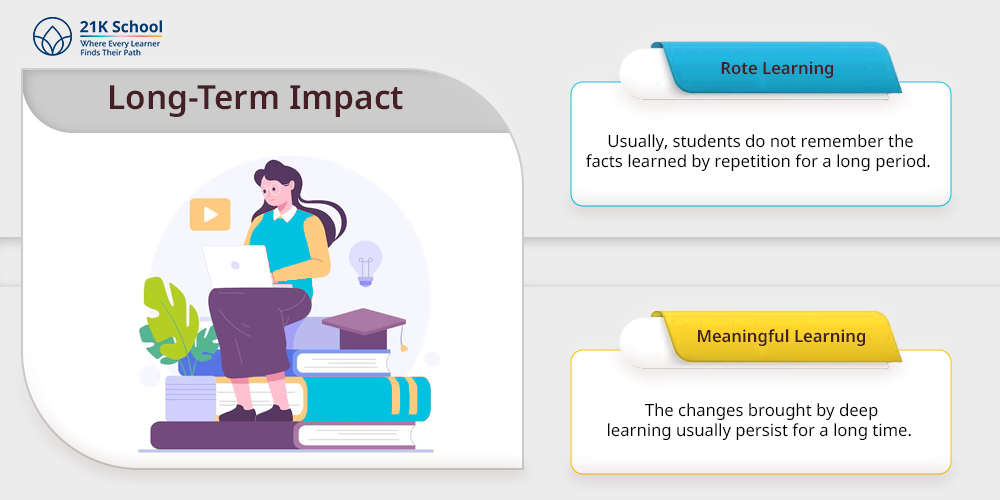
- Rote Learning:
Usually, students do not remember the facts learned by repetition for a long period. Even if a student learns information for a test, it doesn’t mean that they can apply it later.
Concentrating on facts rather than deeper thinking is the skill that you learn the most.
- Meaningful Learning:
The changes brought by deep learning usually persist for a long time. Since students grasp the lessons, they are able to use this knowledge now and in the future.
Thinking analytically, solving problems, and using skills in real life helps people continue learning and succeed in several areas.
Pros of Rote Learning
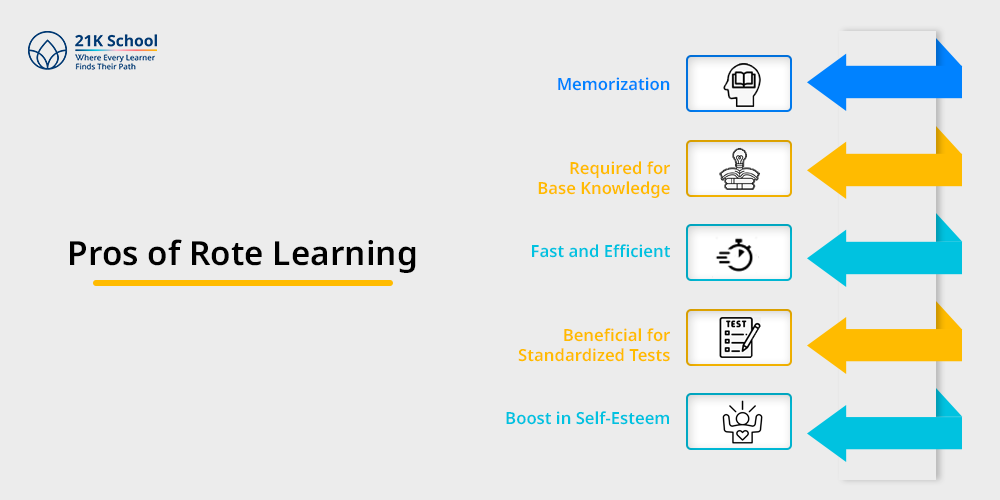
Rote learning is something which is applied from the very childhood of students. Other than forming the base of knowledge required earlier, it has advantages that needs to be talked about:
1. Memorization
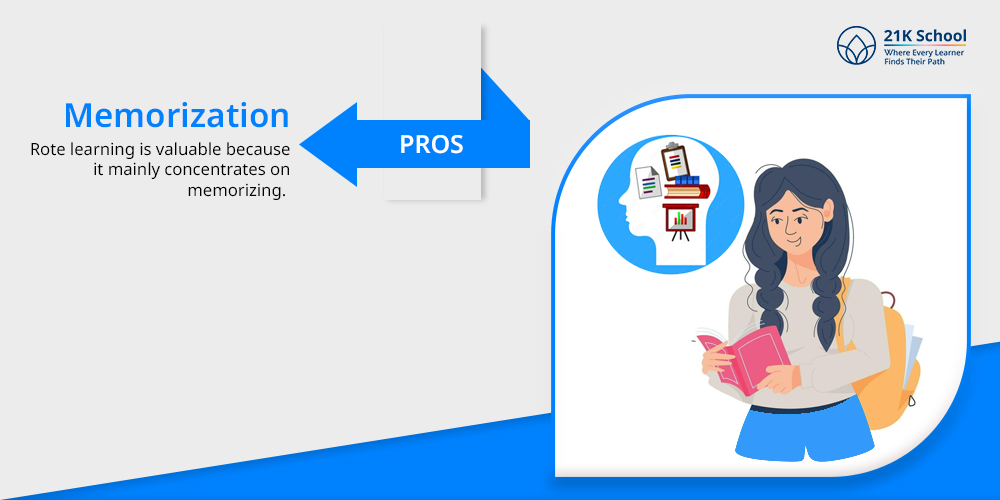
Rote learning is valuable because it mainly concentrates on memorizing. Learners need to remember a lot of details, such as dates, equations or vocabulary.
Here, rote learning makes it simple for students to recall them later.
Go through these memory games for kids that would boost their power of memorization.
2. Required for Base Knowledge
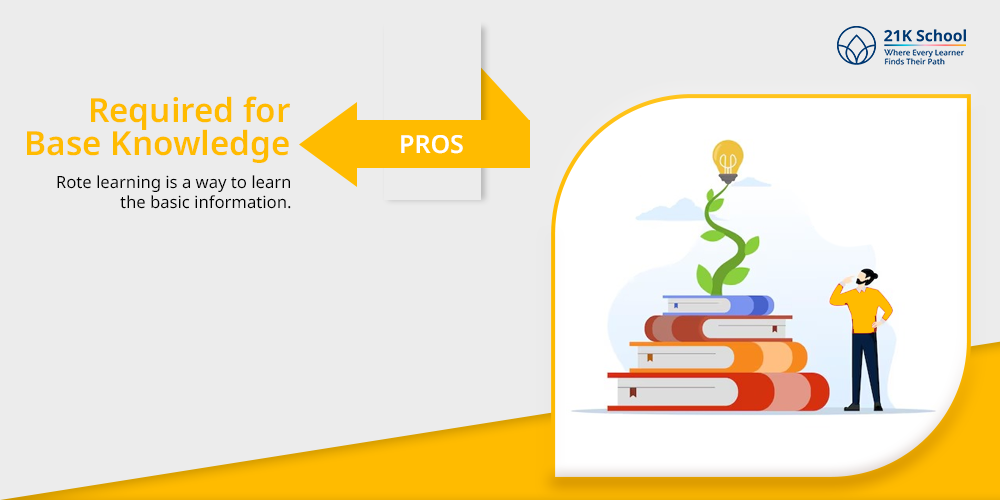
Rote learning is a way to learn the basic information. In mathematics or chemistry, learning and memorizing basic principles helps students later solve difficult problems.
Good memory is important to help build stronger higher-order thinking skills in later periods of life.
3. Fast and Efficient
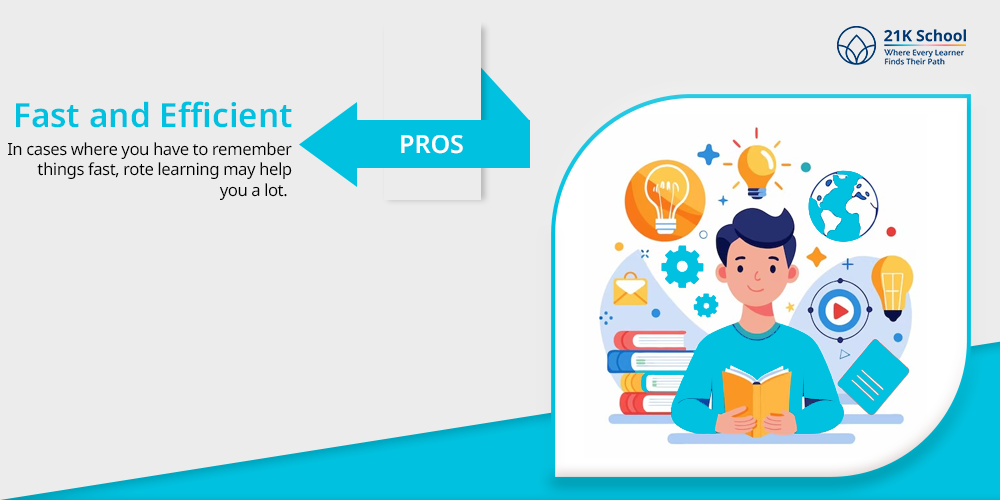
In cases where you have to remember things fast, rote learning may help you a lot. Recognizing patterns in math and recalling dates from history can be done speedily by just memorizing them.
This is extremely useful when you don’t have much time for an exam or a standardized test.
4. Beneficial for Standardized Tests
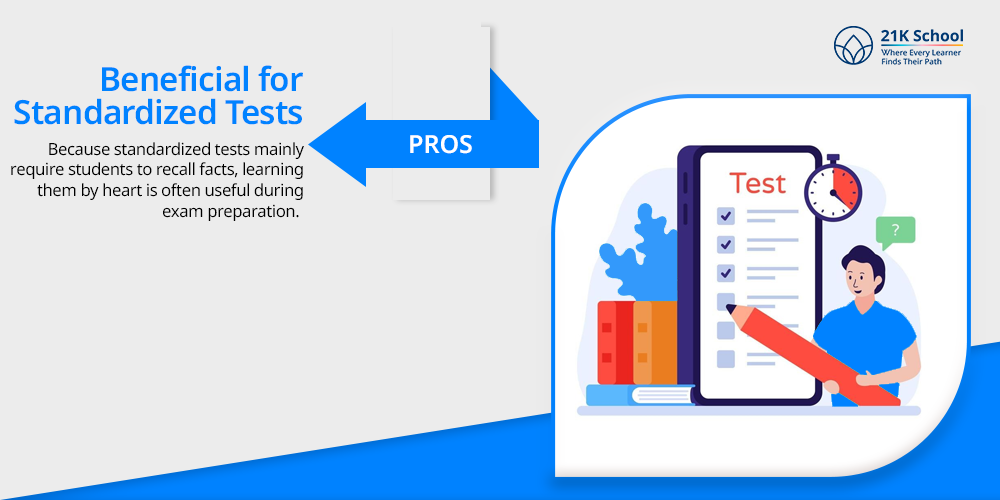
Because standardized tests mainly require students to recall facts, learning them by heart is often useful during exam preparation. Those who have memorized information often do well in situations that only call for recalling details, formulas, or methods.
5. Boost in Self-Esteem
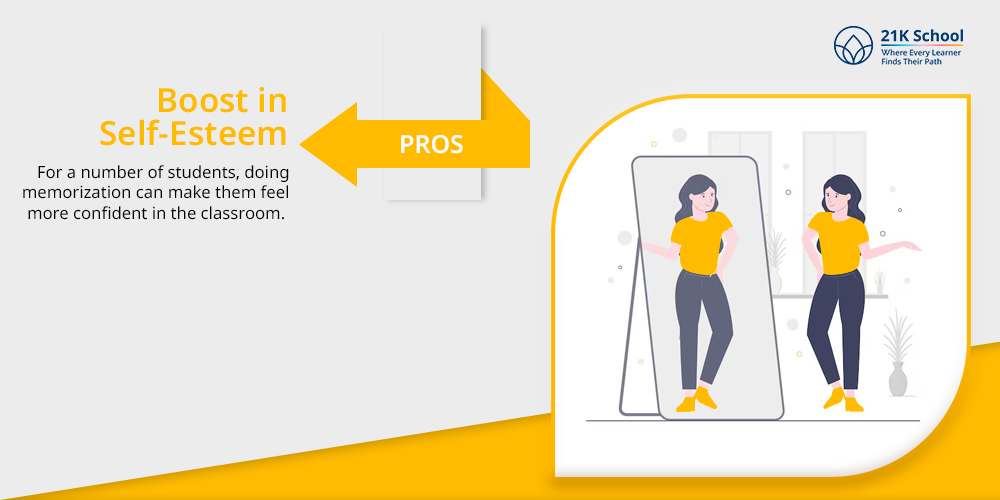
For a number of students, doing memorization can make them feel more confident in the classroom. Being able to recall information accurately can give them pride, mainly when the subject needs us to hold on to what we learned.
Having confidence can make students eager to keep studying. Learn how to build confidence in children and let them succeed in real-life as well.
Cons of Rote Learning
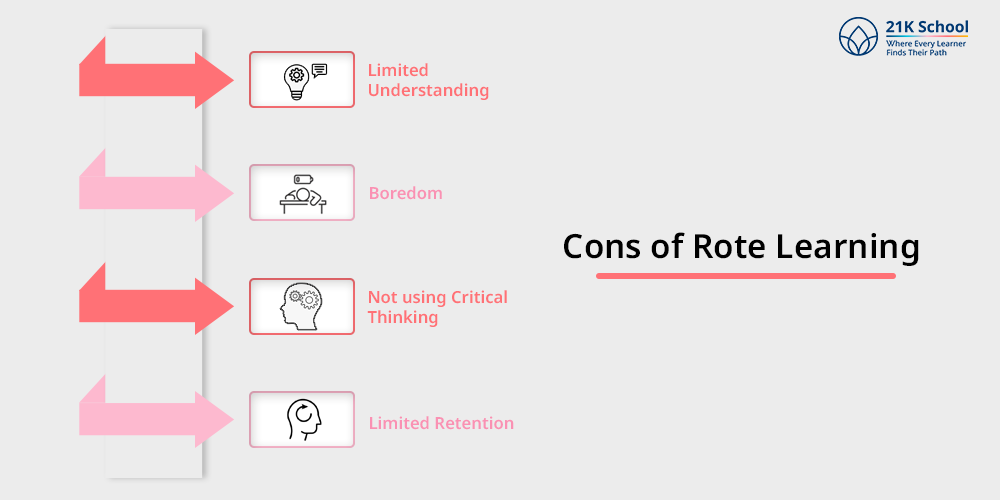
In present times, where skills are the basic demands for industries, rote learning doesn’t suffice. Here, we will be discussing the drawbacks of rote learning, that pulls it back.
1. Limited Understanding
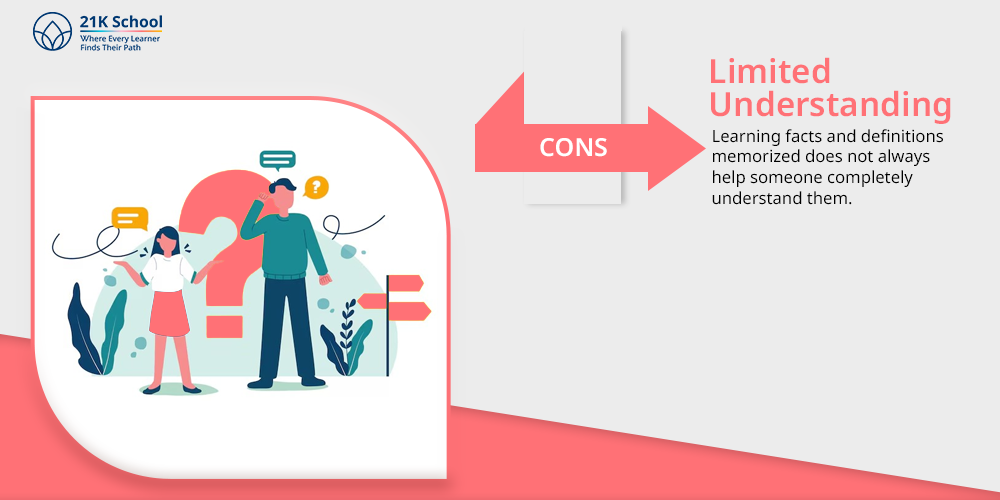
One important disadvantage of rote learning is that it does not help students understand the topic well. Students can sometimes remember facts or equations, yet finding ways to use them in new circumstances is difficult for them.
Learning facts and definitions memorized does not always help someone completely understand them.
2. Boredom
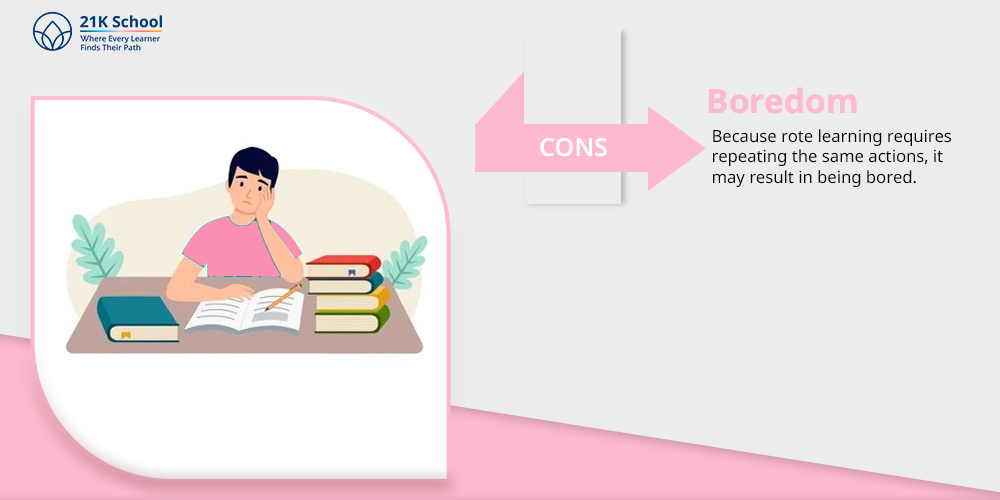
Because rote learning requires repeating the same actions, it may result in being bored. If the curriculum may not interest the students, they may begin to lose interest in school.
Rote learning concentrates mostly on memorizing, which can hinder the skills for both critical thinking and solving issues. Students could bring up facts but struggle to use them wisely in real-life situations.
Therefore, if the content is not meaningful, the learning process may seem boring.
3. Not using Critical Thinking
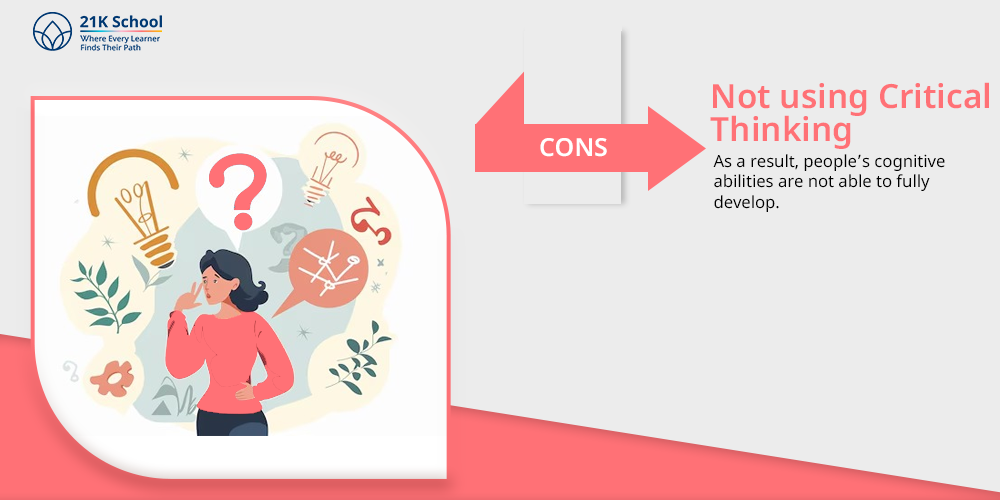
As a result, people’s cognitive abilities are not able to fully develop.
Because information learned this way has no real connection, students might find it hard to apply it to everyday life. This may explain why some people find it hard to understand how and what they learn is pertinent to their lives.
4. Limited Retention

Information that is simply memorized may be forgotten quickly after some time. Unless students use what they’ve learned in different situations, the facts they remember may fade with time.
Pros of Meaningful Learning
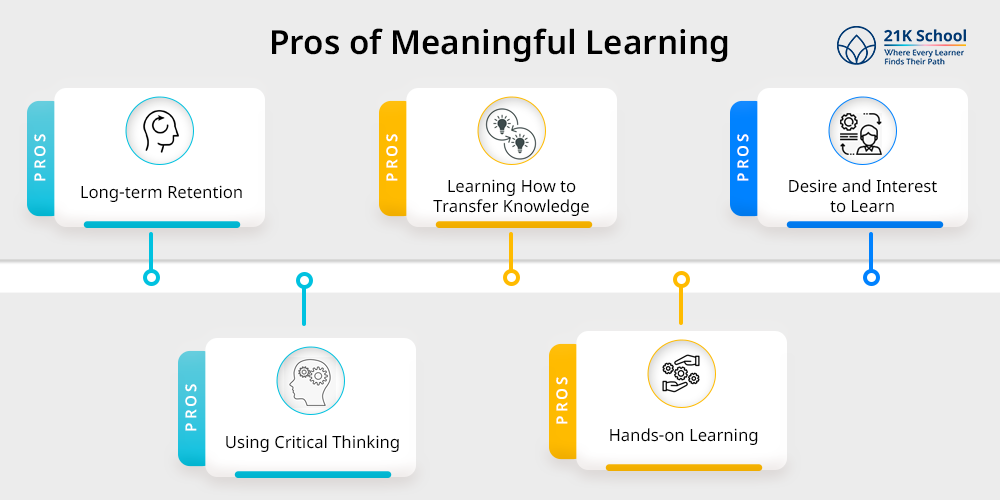
Having a deeper understanding can never go in vain. Meaningful learning provides students with several other benefits, that are discussed below:
1. Long-term Retention
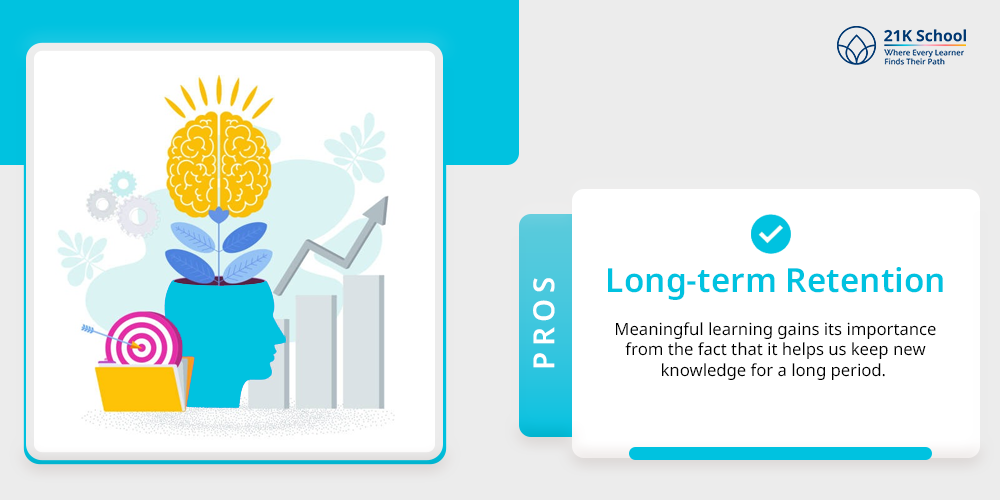
Meaningful learning gains its importance from the fact that it helps us keep new knowledge for a long period. Students who can relate and understand the material are likely to remember it even after a while.
Getting involved with the content you read allows students to remember it for a longer time.
2. Learning How to Transfer Knowledge
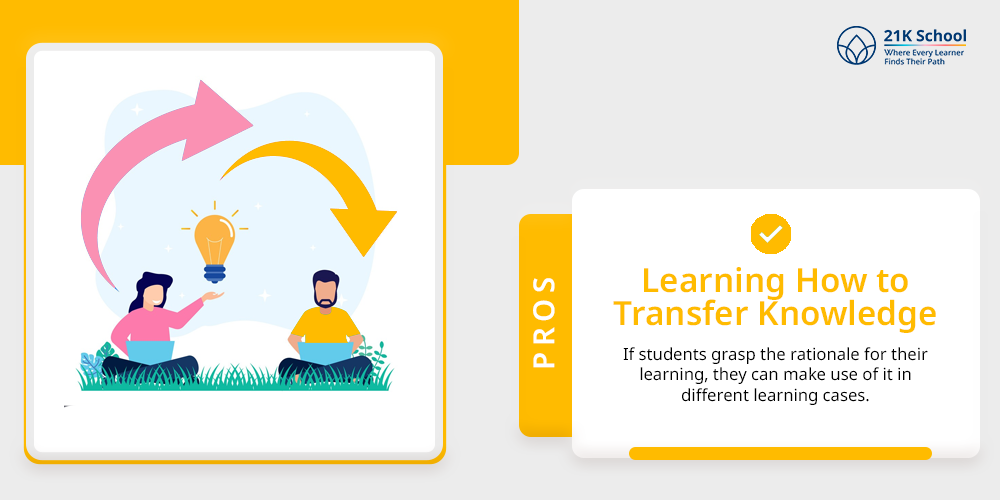
Meaningful learning makes it possible to use knowledge in other contexts. If students grasp the rationale for their learning, they can make use of it in different learning cases.
As an illustration, using real-life cases when teaching science encourages students to solve everyday issues.
3. Desire and Interest to Learn
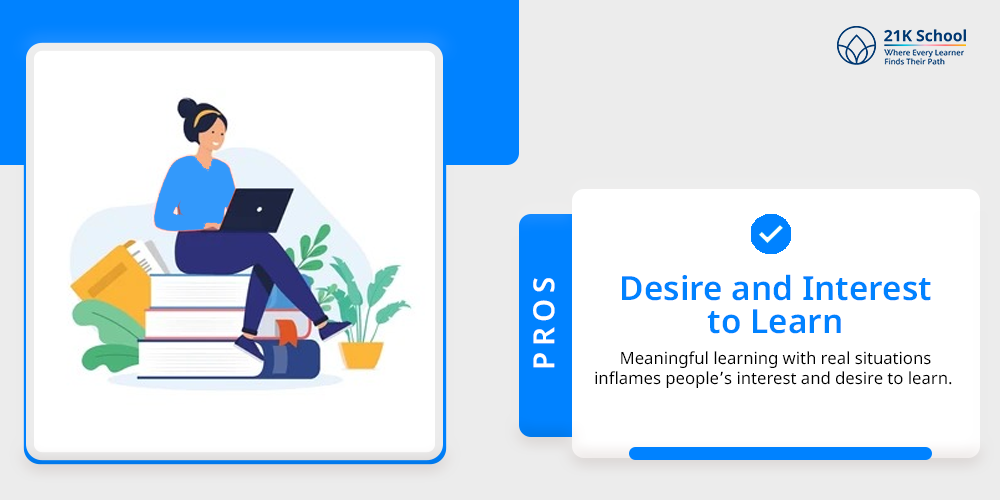
Meaningful learning with real situations inflames people’s interest and desire to learn. The content becomes more engaging for students when they can spot its relevance to what they are or will do in life.
This reason to learn leads to studies that are more pleasurable and fruitful. Explore these activities to encourage curiosity in children and let them learn better.
4. Using Critical Thinking
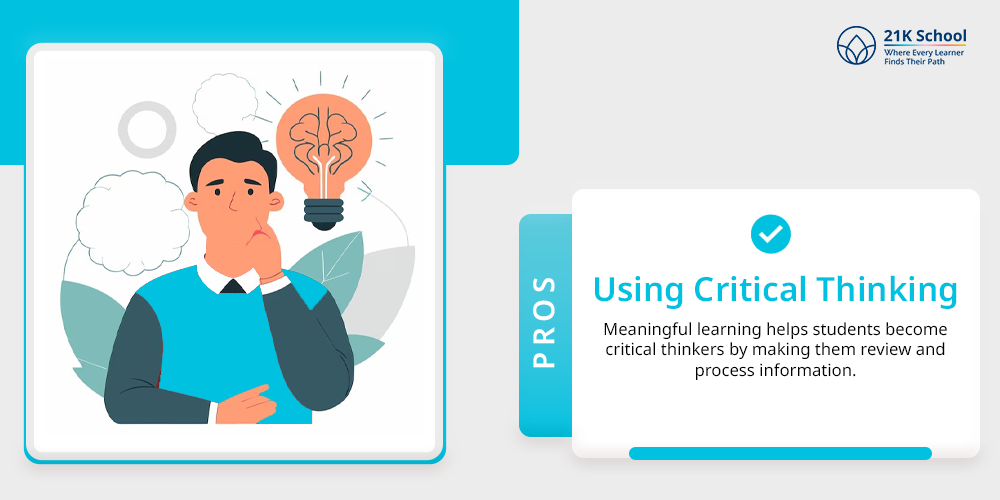
Meaningful learning helps students become critical thinkers by making them review and process information. Rather than only learning details by heart, students learn to doubt their lessons, consider proof, and see the full picture.
5. Hands-on Learning
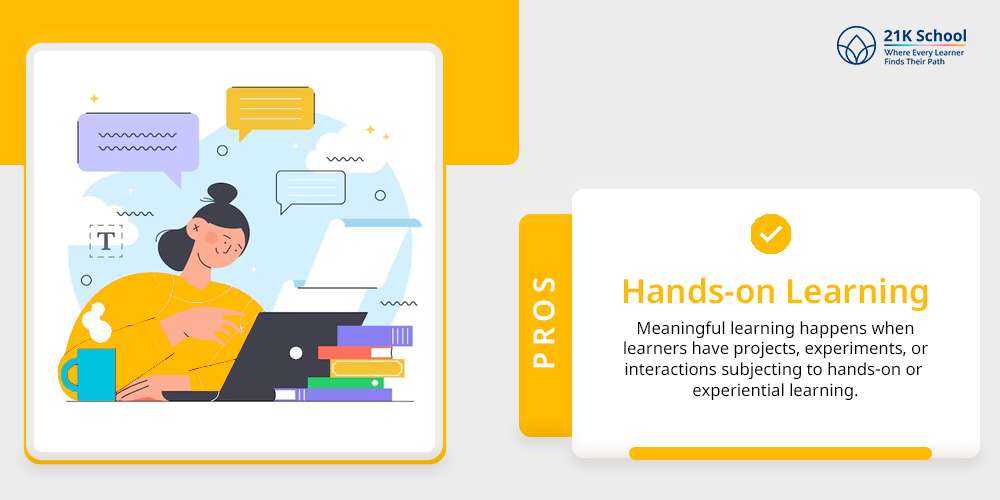
More often than not, meaningful learning happens when learners have projects, experiments, or interactions subjecting to hands-on learning or experiential learning Using this method, students can immediately use what they learn and improve their learning and their ability to solve issues.
Cons of Meaningful Learning
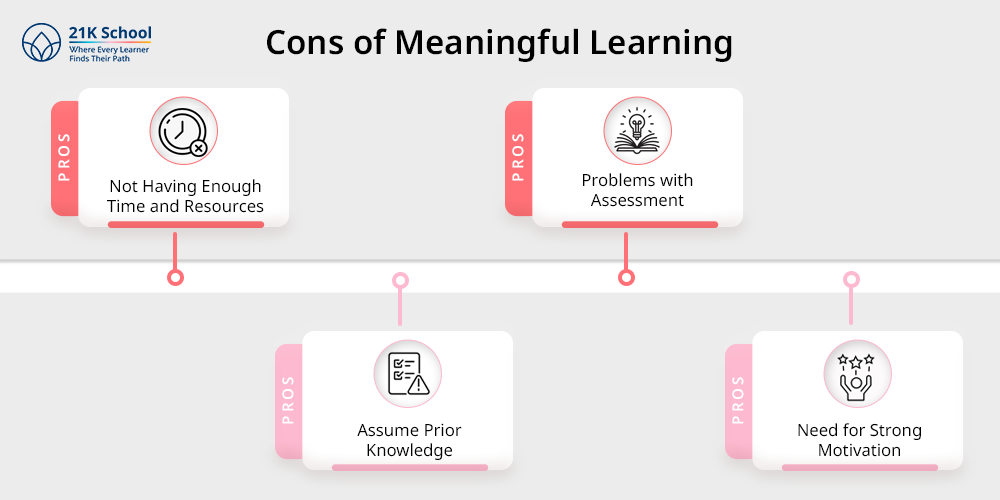
Implementing meaningful learning in classrooms can be daunting due to lack of resources and time. Other considerations under meaningful learning are as:
1. Not Having Enough Time and Resources
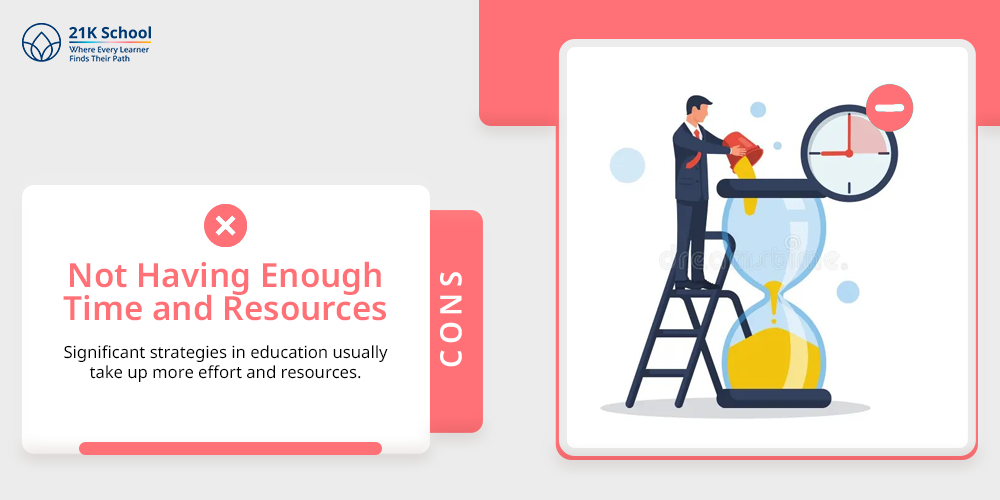
Significant strategies in education usually take up more effort and resources. It is important for teachers to develop lessons that are lively and relevant to every student’s learning process.
Teachers in classrooms without sufficient resources may find this a big problem.
2. Problems with Assessment
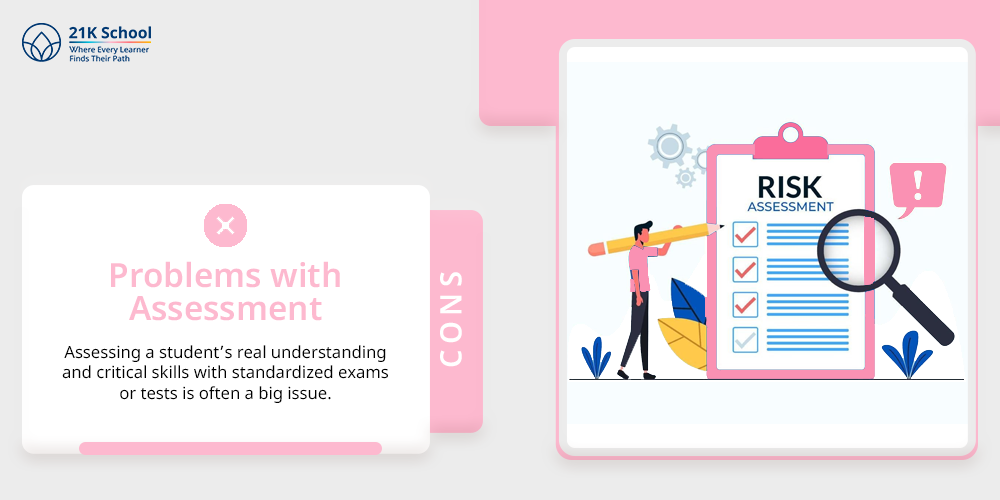
It is usually harder to measure real learning as opposed to rote learning. Assessing a student’s real understanding and critical skills with standardized exams or tests is often a big issue.
3. Assume Prior Knowledge
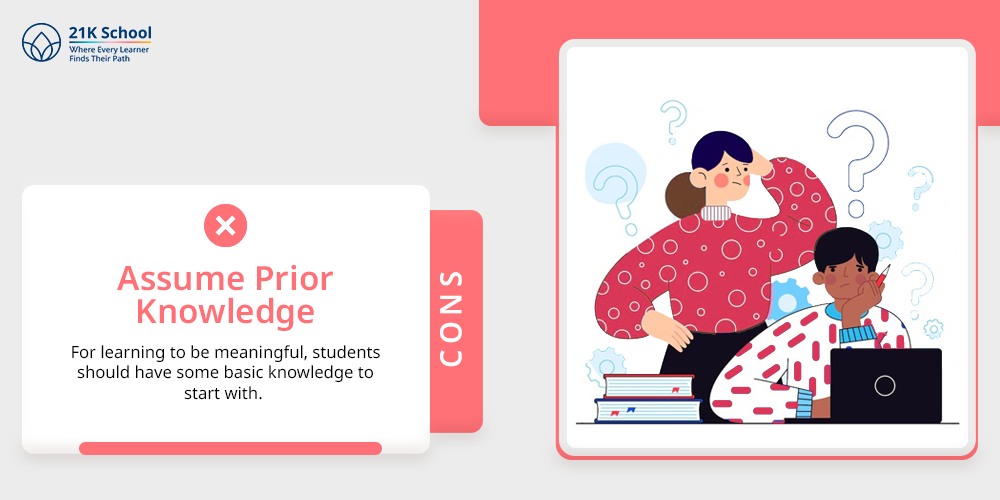
For learning to be meaningful, students should have some basic knowledge to start with. If students don’t have the essential basics, it could be challenging for them to deal with advanced ideas.
If not dealt with early, this problem can cause gaps in education.
4. Need for Strong Motivation
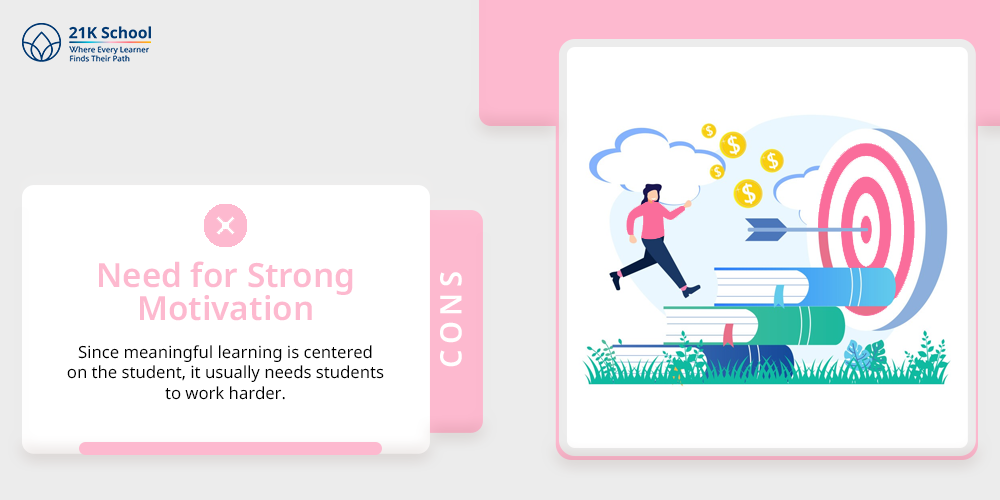
Since meaningful learning is centered on the student, it usually needs students to work harder. Some students might not gain many benefits from this way of teaching if they struggle to relate to the lessons.
What is Better for Student Learning? (Rote Learning or Meaningful Learning)
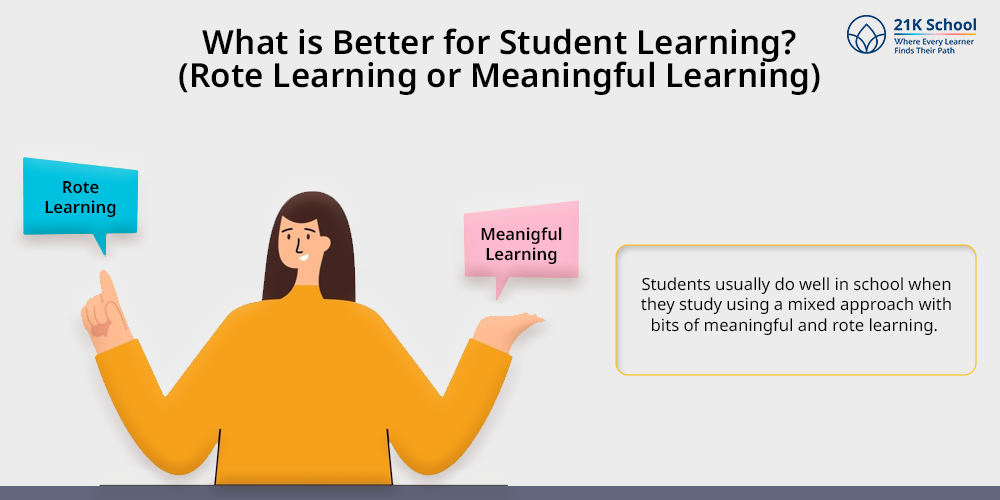
Rote learning and meaningful learning play a purpose in education. If you want to remember basic information or facts rapidly, rote learning helps.
Still, when it comes to important thinking, analysis, and learning something for a long time, meaningful education is superior. Students usually do well in school when they study using a mixed approach with bits of meaningful and rote learning.
Although rote learning gives students a good base, meaningful learning helps them understand and use knowledge in many situations.
Concluding Thoughts
On the whole, meaningful learning is better than rote practice, since its positive effects last longer. Learning that matters encourages people to understand more, reason wisely, and pay more attention.
This is crucial for any achievement in life. Still, rote learning is effective in some occasions, for instance, when you need to learn certain facts by heart fast.
To have a balanced plan, schools and teachers should blend both ways of teaching. So students gain essential knowledge and learn to solve real-life problems with what they learn.

